
|
Sale 34
Pre-Long Beach Coin and Currency Auction
| Lot |
Photo |
Description |
Realized |
Lot 1431 |
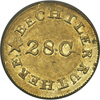 |
Christopher Bechtler, ONE DOLLAR CAROLINA, 28 gr., N reversed. PCGS graded AU-53. Lots of luster remaining. It is unusual to us that this piece could have survived so well preserved, with so few marks and such splendid luster within the legends, when most of these long ago disappeared or were struck into federal coinage once the Dahlonega and Charlotte Mints opened in 1838. This attractive coin, graded About Uncirculated 53, has all of the high quality standards imparted to it by Christopher Bechtler's mint. Pop 12 with 31 better (PCGS # 10055) .
Estimated Value $3,000 - 3,500.
View details and enlarged photos
Check results on similar lots
| Realized
$4,140 |
Lot 1432 |
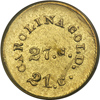 |
August Bechtler, 1 DOLLAR CAROLINA, 27 gr. 21 carats. PCGS graded MS-61. This is the most affordable and most often seen of the various Augustus Bechtler pieces, a lovely golden to greenish yellow example struck from native Carolina gold. Lustrous with striated toning, the piece can become a part of your growing coin collection if you only attend the sale and place a bid. Pop 11; 7 in 62; 6 in 63. (PCGS # 10040) .
Estimated Value $3,500 - 4,000.
View details and enlarged photos
Check results on similar lots
| Unsold |
Lot 1433 |
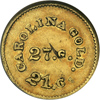 |
August Bechtler, 1 DOLLAR CAROLINA, 27 gr. 21 carats. NGC graded AU-55. A lamination or impurity streak is noted on the obverse, but this is generally well struck and choice with luster.
Estimated Value $3,000 - 3,500.
View details and enlarged photos
| Unsold |
Lot 1434 |
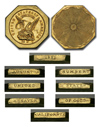 |
1851 U.S. Assay Office $50 "slug", 880 THOUS. Lettered edge, reverse rays. NCS graded Sharpness of AU-50 Obv. Tooled. Fabricated Rev. Breen-7705, Type of Kagin-3, KM 31.4; not in Adams. The unique, controversial "Rays from central star" variety, ex Peltzer, McAllister specimen. Our records indicate that the last time this $50 slug was offered was in Mssrs.Glendining & Co., Limited's sale of the Peltzer Collection of American Coins, June 20, 1927, Lot 50, where it realized 125 English pounds (or approximately $600). Described in that sale as "a brilliant proof in mint state, of the highest rarity" the seeming contradiction in terms is typical of grade descriptions from the early auctions of the 20th century.
The obverse is in the Augustus Humbert style, octagonal format, with 50 D G hand stamped into the planchet. A lettered edge. UNITED STATES OF AMERICA, eagle, with 880 THOUS above. On the edge is inscribed AUGUSTUS HUMBERT UNITED STATES ASSAYER OF GOLD CALIFORNIA 1851. The records from the Humbert and Assay Office are silent on this piece; conversations with Dr. Donald Kagin also confirm that there is no written material known about it. No one can say whether it was a pattern issue made at the behest of Humbert, or a test piece, but in the hundred and fifty-plus years since it was struck, no other example with the "rays from central star" reverse has even been rumored!
The coin has the standard lettered edge seen on this series of $50 ingots with AUGUSTUS / HUMBERT / UNITED / STATES / ASSAYER / OF GOLD / CALIFORNIA / 1851 made by hand-stamping each complete word into one segment of edge.
For many years, this coin was listed and photographed in the Guide Book and was removed from the 2006 Edition.
Now to the difficult part: in discussions with the two grading services, NGC and PCGS, this coin, definitely a genuine 880 THOUS $50 Humbert slug, was considered to be altered, with the obverse tooled in the fields to smooth them. As for the reverse, opinion varies but seems to be that it is entirely "chased" or reengraved at a time and by persons unknown. Since the last catalog sale of this piece in 1927 has a photograph that shows the coin as it looks today, the work presumably was done before that year. Sometime between 1851 and 1927, therefore, a genuine example of the very rare lettered edge, 880 THOUS. $50 was reworked. Whether it was done on one of the plain engine-turned reverses or a reverse with a central "50" cannot be known. But the new design, with a six pointed star with rays and rippled "engine turned" effect is bright and new appearing. This seems to point to someone with talent as an engraver who had a hand in the work, or someone with access to an engine-turning lathe of the type Humbert's Assay Office might have used to make the original engine-turned dies.
Original models of the $50 ingot obverses were made by the illustrious sculptor and medallist Charles Cushing Wright under subcontract from the Philadelphia Mint. Humbert, who had been a watchmaker in New York, created the engine-turned reverses on the regular slugs, but whether it was Humbert himself, or someone who followed him later that made this reverse is impossible to tell. We are mentioning this so that bidders will understand the unique nature of this intriguing piece. For years it has been listed in Dr. Donald Kagin's reference book on Territorial Gold coins. But Dr. Kagin, since he saw this coin several years ago, has decided to withdraw the listing from the next edition of his book. In a telephone discussion with us in December 2005, he said he was not convinced that the star with rays reverse was a product made by Humbert himself or the Assay Office. The Guide Book of United States Coins, as well as the Walter Breen encyclopedia of United States coins simply lists this as "rays from central stars" but in cryptic references to the 1927 sale or simply as "Unique." We are offering it AS IS to bidders in the hope that further research will be undertaken. At the very least, it is a beautifully reengraved reverse on a genuine and rare $50 1851 lettered edge ingot or "slug" of the 880 THOUS. Type. At the very most, this is a genuine product of Hubbert with a unique reverse.
Our personal conclusion is this: The weight is correct (84.1 gr.) the edge lettering is correct and the obverse die is the same as used on the normal 880 THOUS issues. The "chasing" in the fields is something medalists did during the period and is commonly seen on European and American medals. In fact, we have handled pocket watches of the period with a very similar engine turned design that has the same "look". The reverse could not be "lasered" (one expert claimed) as this process was unknown until recently. In addition, the reverse could not have been planed and reworked since the weight would differ. We know this coin was made prior to 1927 and inspite of the polishing, we believe this to be a product of the period, struck in the year 1851.
The coin will certainly make a conversation piece among collectors and non-collectors alike. Certainly worthy of more numismatic research as this is exactly what makes numismatic study such an exciting endeavor.
Estimated Value $25,000 - 50,000.
Ex Peltzer Collection of American Coins, Glendining & Co. June 20, 1927, lot 50.
View details and enlarged photo
| Realized
$66,125 |
Lot 1435 |
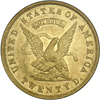 |
1853 U.S. Assay Office $20 Gold, 900 THOUS. PCGS graded MS-62. Well struck with lovely light gold color. Pop 23; 23 in 63 11 in 64, 4 in 65. Assay Twenties were the workhorse gold coins in Gold Rush California of the 1850s and 1860s. As such, they are only on occasion found in Uncirculated grades even though hundreds of thousands were produced. These are the most available territorial gold issues. The date 1853 precedes by one year the opening of the San Francisco Mint. Few know it, but this 1853 Assay $20 gold is, in fact, an official issue of the United States Government. As such, it is legitimately collectible as an issue that should be considered part of the Federal double eagle series. Given the 90% gold content, the same as Federal double eagles, this is closely associated with twenty dollar gold coins. This piece is sharply defined throughout with notably strong luster on the eagle's main elements. The green-gold surfaces show a few typical light abrasions and have just outstanding quality for Mint State 62 quality. See page 299 of the 2005 Guide Book for further information on the Unites States Assay Office gold pieces (PCGS # 10013) .
Estimated Value $9,000 - 10,000.
View details and enlarged photos
Check results on similar lots
| Realized
$10,925 |
Lot 1436 |
 |
1853 U.S. Assay Office $20 Gold, 900 THOUS. NGC graded MS-62. Well Struck and untoned. Pop 42; 18 in 63, 11 in 64, 2 in 65. Another outstanding example of this Territorial gold issue, the obverse has a tiny dent mark in the field below the fineness ribbon, a mark or two on the eagle's shield, and several others in the left obverse field as well as one tiny mark along the lower rim, all in line with the choice but not gem grade level assigned as MS62. Keen-edged devices throughout, including feathers, shield, and legs of the main device (PCGS # 10013) .
Estimated Value $9,000 - 10,000.
View details and enlarged photos
Check results on similar lots
| Realized
$10,925 |
Lot 1437 |
|
1849 Miners' Bank (San Francisco) $10 Gold. NGC graded AU-58. Natural orange and gold toning. Rarity-6. A rare and historically noteworthy territorial issue, this gold $10 Miners Bank piece is the more commonly seen variety struck on a orange-gold planchet with high copper content accounting for the warm color. The surfaces are remarkably clean, fresh, and lustrous for this grand-looking rarity, with the eagle well defined in the center, and no sign of the sometimes-seen weakness on the wing tips. There are adequate amounts of mint frostiness remaining around the devices. This luster also extends well into the fields. A very pleasing coin overall and sure to be of high interest to advanced territorial collectors who can afford a major purchase like this. Pop 4; 6 finer.
Two different issues were produced, and they are distinctive for either brilliant orange-gold color or attractive green-gold color. It is believed that the orange colored pieces (Kagin 1) were die trials produced in the east, while the green-colored pieces (Kagin 2) were struck in native California gold. Donald Kagin suggested that the Kagin-1 coins were struck with a collar, after which the obverse and reverse dies were transported to California, where the Kagin-2 coins were struck without a collar. These latter coins had the characteristic of weak lettering in CALIFORNIA, being struck on a constricted planchet.
Because official assays at the time rated these coins at 866 Fine (some even with copper alloy), valued at about $9.65, they became unpopular; brokers valued them at $8 apiece (San Francisco Daily Alta California, April 11, 1850, p. 2). This accounts for their short existence and hence, great rarity.
Estimated Value $45,000 - 55,000.
View details
| Realized
$57,500 |
Lot 1438 |
 |
1852 Wass, Molitor & Co. (San Francisco) $10 Gold. Large head. PCGS graded AU-50. A very attractive specimen in spite of its uneven detail, with faint greenish yellow surfaces that still bring the bright and hard-working luster forward from the devices. Some weak spots in strike is seen at the rims, stars, date, tops of the main devices, etc., which only goes to show the difficult conditions faced by these early California gold minter working with inadequate equipment and inexperienced workers. A rare Type and one of the higher grade specimens reported. Pop 13; 12 finer. (PCGS # 10348) .
Estimated Value $8,000 - 10,000.
Central America Treasure.
View details and enlarged photos
Check results on similar lots
| Unsold |
Lot 1439 |
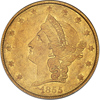 |
1855 Kellogg & Co. (San Francisco) $20 Gold. PCGS graded EF-40 PQ. Lovely green color with some lustre evident. The obverse depicts a portrait of Liberty adapted from the $20 design of 1849-1907, but with her coronet inscribed KELLOGG & CO. Thirteen stars surround, and the date 1855 is below. The reverse has an elegantly designed perched eagle in the style of Longacre's $20 with a glory of stars and rays above. Kellogg struck large quantities of twenties and fifties in 1855 but soon thereafter, most of this firm's circulating coinage was withdrawn and sent to the newly opened mint to be turned into Federal $20 gold pieces. Pop 12; 39 finer. (PCGS # 10225) .
Estimated Value $4,500 - 5,000.
View details and enlarged photos
Check results on similar lots
| Realized
$5,463 |
Lot 1440 |
|
1849 Oregon Exchange Co. (Oregon) $10 Gold "Beaver". PCGS graded EF-45. Edge cut on the reverse at 4:00. Mintage of 2,850. Rarity-6 with 13 to 16 known per Breen. Production of gold coins by the Oregon Exchange Company consists of two denominations, both dated 1849: $5 and (the far rarer) $10. Engraved by Victor M. Wallace, the dies for the $10 omitted the errors of their $5 cousin by changing T. O. to O. T. (for Oregon Territory) and correcting John Campbell's initial from G to C at the upper obverse border. (But the initials for Abernathy and Wilson were removed because, despite their being co-founders of the Oregon Exchange Company, they did not provide any of the money required to purchase the coinage equipment, according to accounts of the period.
Operations at the company ceased on September 1, 1849 after only a few short months. These key pieces, as well as the more often seen $5 issue, were made from "native" gold as deposited from the various gold mining districts in California. As a result, the coins were given a premium of up to 10 percent more than Federal issues of the same denominations. These circulated widely in the region from Canada to California and Nevada district and their high intrinsic value may have led to extensive melting.
Only about a dozen or so Oregon Exchange Company Ten Dollar gold coins are know, and this is the first example to appear in one of our auctions in awhile. The surfaces display localized abrasions, but the overall appearance is quite a bit smoother than one would expect for gold coin that saw 25 points of wear (assuming a new one would have graded MS70, which is problematic). Struck from the native silver alloyed gold, and as a result the surfaces have a greenish-yellow shade. The imprint that was left by the Oregon $10 dies lacks a certain clarity, but it is normal for this date, and unevenness is seen on the few known survivors. Although the beaver's fur is only partially evident, all the devices and lettering are readable. This coin's great rarity dispels any suggestion that collectors will approach the coin casually; it is one of the finer specimens known, made even rarer because there are a half dozen impounded in museums! Pop 2; 2 in AU-55. Only 6 graded by PCGS. NGC has graded a single coin EF-40. (PCGS # 10291) .
Estimated Value $250,000 - 300,000.
Ex: Brand, T.C. Pham.
View details
Check results on similar lots
| Unsold |
Lot 1441 |
|
1849 Mormon $5 Gold. PCGS graded AU-58. Nice with light golden toning. Once the Gold Rush in California began in earnest in 1849, enough gold dust had found its way into the Mormon treasury to begin private gold minting. On November 25th of 1849, Brigham Young, John Kay, and John Taylor formed a consortium to design the symbols used on these intriguing gold pieces. Although no records seem to survive, we know today approximately how many were struck. Breen estimates the total to be around 5,300 coins. This is the first of the three $5 issues produced by the Deseret Assay Office, the others being in 1850 and 1860 (beehive coinage). Of course, it is a rare coin in all grades, with sufficiently few at the About Uncirculated level to excite just about every collector of Territorial gold who contemplates owning a Mormon five. The surfaces are bright gold in color with a hint of olive and are minutely granular, but not at all atypical for the Type. It is no secret either, since the photos reveal all, that the two clasped hands are fully struck, , which is another reason why territorial collectors will fall in love with it. A couple of wispy marks and hairlines are only detectable under a lens. Estimated mintage [Breen], 5,340. Pop 3; 1 in 60 as finest at PCGS. (PCGS # 10262) .
Estimated Value $45,000 - 50,000.
View details
Check results on similar lots
| Unsold |
Lot 1442 |
 |
1860 Mormon $5 Gold. NGC graded MS-62. An outstanding Mint original example of this well-designed and historic gold piece from the Great Salt Lake, and probably among the very finest of the 50 or so pieces that exist from an original reported mintage of 472. Balanced light yellow gold color with profuse luster, especially with the protected sections of the margin. Light signs of handling, in harmony with the grade, digs in upper right obverse field above the lion's back, short horizontal dig between legends inside rim at 11:00 on obverse. The reverse shows less chatter than the obverse, and both sides are superbly struck and very attractive to study. Engraved by a Salt Lake City jeweler and struck in the first months of 1861, the 1860 Mormon pieces were to represent the Church's final foray into gold coinage, these inspired by the recent Colorado gold rush that supplied the gold used in their production. The greatest concentration of these are in the EF-AU range, with a piece as fresh-looking as this one necessarily standing among the finest that have survived of this very rare issue.
Well struck and lustrous. Pop 4; 2 in 63. The population in MS-62 has doubled since October 2004, which probably indicates resubmissions in hopes of achieving "finest certified" status. PCGS has certified only one piece as Mint State, a single MS-61 which may also be represented in the NGC certification information.
From the estate of Jack Klausen; certified by PCGS in December 1989, then the finest seen; offered in Heritage's sale of September 2002, Lot 9029. Well struck and lustrious.
Estimated Value $60,000 - 75,000.
View details and enlarged photos
| Unsold |
Lot 1443 |
|
1860 Clark, Gruber & Co. (Denver, Colorado) $10 Gold. PCGS graded MS-62. The Pikes Peak. Rich golden toning on both sides. Semi prooflike surfaces. K-3, R.5. An intermediate-late die state, lacking only the die crack from the bottom of the R and through the E in GRUBER. Always an interesting issue with the Mount Fuji shaped obverse die created back East by someone who had never seen the real Pike's Peak that lies jutting over the western approaches of the present city of Colorado Springs. Very scarce as such and always in demand by territorial collectors, this is a lovely piece that exhibits just a wonderful rich vein of reddish-amber patina over the yellow-gold color of the native Colorado ore used to strike these coins. A small planchet flake is located above the R in GRUBER, otherwise just a few small field marks are present on each side. A great deal of discussion also surrounds a coin's strike. This has impeccable detail with no sign of weakness to the main central devices, a key point when evaluating such an historic offering. Pop 7; 2 in 63 best by PCGS. (PCGS # 10137) .
Estimated Value $60,000 - 65,000.
View details
Check results on similar lots
| Unsold |
Lot 1444 |
 |
1855 Kellogg & Co (San Francisco) $50 Gold Commemorative Restrike. PCGS graded Gem Proof. Struck in San Francisco September 9, 2001. These huge gold coins were struck from transfer dies made from the original 1855 Kellogg and Company dies. The planchets were made from original Kellogg and Humbert assayers gold ingots recovered from the S.S. Central America treasure. This coin has a stamp on the reverse above the eagle showing "Struck September 9, 2001. C.H.S." (California Historical Society). This coin also bears an inscription "S.S. Central America Gold, C.H.S." on the reverse ribbon. This coin is listed in the Guide Book on page 299.
This coin comes with a custom hand-hammered copper frame with gold imprinted purple ribbons -- modeled after the San Francisco Jewelers Shreve & Co., for the famous 1915-S Panama-Pacific commemorative coins, and all is housed in a custom box.
Less than 5000 of these coins were minted in 2001 and they have retailed for $5000. The original 1855 $50.00 round Kellogg & Co. coin sells in excess of $150,000 when available. A truly historic commemorative coin struck from the actual gold recovered from the S.S. Central America ship wreck.
Estimated Value $3,000 - 3,500.
View details and enlarged photos
| Realized
$3,680 |
Lot 1445 |
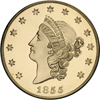 |
1855 Kellogg & Co (San Francisco) $50 Gold Commemorative Restrike. Gem Proof. Struck in San Francisco September 10, 2001. These huge gold coins were struck from transfer dies made from the original 1855 Kellogg and Company dies. The planchets were made from original Kellogg and Humbert assayers gold ingots recovered from the S.S. Central America treasure. This coin has a stamp on the reverse above the eagle showing "Struck September 10, 2001. C.H.S." (California Historical Society). It also bears an inscription "S.S. Central America Gold, C.H.S." on the reverse ribbon. See the listing in the Guide Book of United States Coins on page 299.
Fewer than 5000 of these pieces were minted in 2001 and they have retailed for as high as $5000. An original 1855 $50.00 round Kellogg & Co. coin sells in excess of $150,000 when available. A truly historic commemorative coin struck from the actual gold recovered from the S.S. Central America ship wreck. No frame with this lot.
Estimated Value $2,500 - 3,000.
View details and enlarged photos
| Realized
$3,450 |
Lot 1446 |
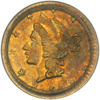 |
Round Liberty Quarter Dollar. BG-204. Rarity 5. PCGS graded MS-61. Toned on both sides. Pop of 4 with 18 finer.
Estimated Value $700 - 800.
B & M Sale, March 2000.
View details and enlarged photos
| Realized
$661 |
Lot 1447 |
 |
1869 Octagonal Liberty Quarter Dollar. BG-748. Rarity 5. PCGS graded MS-62. Flashy prooflike surfaces. In an old green label holder. Pop of 10 with 8 in MS-63 and 2 in MS-64 (PCGS # 10575) .
Estimated Value $600 - 700.
Superior's Auction, Feb. 1997.
View details and enlarged photos
Check results on similar lots
| Realized
$546 |
Lot 1448 |
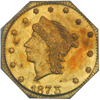 |
1875 Octagonal Liberty Quarter Dollar. BG-777. Low Rarity 7. Encapsulated by PCGS "Genuine" with no stated grade. Our grade is Sharpness of MS-60 with slightly creased prooflike surfaces. This is the Doering plate coin. PCGS reports only 7 coins in total.
Estimated Value $2,000 - 2,500.
B & M Sale, Jan. 1995.
View details and enlarged photos
| Realized
$1,898 |
Lot 1449 |
 |
1922 Grant Gold Dollar, with star. PCGS graded MS-66. A lovely untoned gem. Nice reddish-gold luster reflects off the fields of this pristine Grant Memorial Gold Dollar. Add to all this that mathematically exact standards are seen in the sharp centers, and you find a coin with far from "average" detail in the key high points, such as Gran'ts hair above the ear and the trees above his birthplace on the reverse (PCGS # 7459) .
Estimated Value $3,800 - 4,200.
View details and enlarged photos
Check results on similar lots
| Realized
$4,255 |
Lot 1450 |
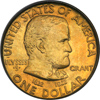 |
1922 Grant Gold Dollar, no star. PCGS graded MS-64. Delicately toned. Nice apricot-gold luster reflects off the fields. It is easy to see this piece was delivered a full, sharp blow by the dies, leaving behind a choice, crisp appearance.
Ulysses S. Grant was born Hiram Ulysses Grant. At Ulysses' birth, his family had not decided on what to name him. Eventually, each member of the family wrote a name on a piece of paper and dropped it into a hat. They drew the name Hiram Ulysses Grant from the hat, and that became his name. He was known as Ulysses to his family and friends.
Ulysses attended the United States Military Academy at West Point. When Ulysses registered, his name appeared on West Point's records as Ulysses Simpson Grant, rather than Hiram Ulysses Grant. So, Ulysses changed his name to Ulysses Simpson Grant. He was known as U.S. Grant or "Uncle Sam" Grant. His good friends shortened this name and called him Sam (PCGS # 7458) .
Estimated Value $2,800 - 3,000.
View details and enlarged photos
Check results on similar lots
| Realized
$3,278 |
Lot 1451 |
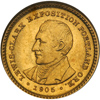 |
1905 Lewis and Clark Gold Dollar. NGC graded MS-63. Nice rich golden colors. Flowing rivers of golden frost from edge to edge with only an occasional hairline or scuff mark disturbing the otherwise very choice surface. Sharply struck on obverse and reverse portraits. Lewis and Clark performed a feat that was closely followed by the Eastern public as they explored the vast Louisiana Purchase in 1804-06 (PCGS # 7448) .
Estimated Value $1,800 - 2,000.
View details and enlarged photos
Check results on similar lots
| Realized
$2,185 |
Lot 1452 |
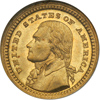 |
1903 Louisiana Purchase-Jefferson Gold Dollar. NGC graded MS-64. Luxuriant orange-gold color is seen over each side with light accents of frost everywhere. Keen-edged devices throughout, including Jefferson's wig. Jefferson, by the way, was a red head with thining hair according to paintings done at the time of his Presidency. He wore a wig (as pictured) which was traditional with both men and women of the wealthier classes in post-colonial America (PCGS # 7443) .
Estimated Value $1,800 - 2,000.
View details and enlarged photos
Check results on similar lots
| Realized
$2,243 |
Lot 1453 |
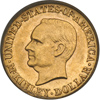 |
1916 McKinley Gold Dollar. PCGS graded MS-65. Both sides display an exceptional frosty sheen and nice satiny brilliance, being predominately yellow-gold with a touch of reddish color. McKinley appears on gold dollar commemoratives dated 1916 and 1917 as well as on an earlier Lousiana Purchase dollar struck in 1903. Many consider McKinley to be America's first Imperial President because of his expansionist policies in acquiring Cuba, Hawaii, the Philippines, and other territories by force of arms (PCGS # 7454) .
Estimated Value $2,000 - 2,200.
View details and enlarged photos
Check results on similar lots
| Realized
$2,243 |
Lot 1454 |
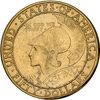 |
1915-S Panama-Pacific Gold $50 Round. PCGS graded MS-63 PQ. Remarkably clean surfaces with very few faint hairlines. A delightful choice specimen of this singularly beautiful commemorative gold issue. Rich golden surfaces display some pale toning iridescence and a modicum of small contact marks. Indeed, this handsome, well struck coin is free of all but the most trivial marks and hairlines. The $50 round issue, along with the related octagonal format coin, is the only $50 denomination gold coin issued by the United States Mint (until the recent advent of the American Eagle gold bullion coin series, which carry a fictitious $50 face value). Just 483 of the round $50 coins were distributed, thereby creating the rarest of all American commemoratives struck during the past century. Pop 122; 78 in 64; 8 in 65. (PCGS # 7451) .
Imagine the advances in technology which had to be overcome before these massive 2-1/2 ounce gold pieces could be minted. The Philadelphia Mint's fourteen-ton medal press was shipped by train and set up at the San Francisco facility for the striking ceremonies for the Panama-Pacific $50 gold pieces. It is claimed this press could strike a coin with a pressure of 450 tons per square inch. By comparison, Morgan Silver Dollars required no more than 150 tons of force. This medal press struck 1,500 of each $50 gold piece, for a total 3,000 coins or nearly 7,500 ounces (value today at $380 an ounce = $2,775,000). Unfortunately, there were few takers at the $100-per-coin asking price and so only 645 Octagonal and 483 Round 'fifties were sold. The overage was melted.
Estimated Value $50,000 - 55,000.
View details and enlarged photos
Check results on similar lots
| Realized
$62,100 |
Lot 1455 |
|
A Collection of "Special Edition" $5.00 Gold Commems all designed and signed by Elizabeth Jones. Each encapsulated by ICG and signed by Elizabeth Jones in black ink. Each holder #211 of 250. Consists of: 1986-W ICG MS-70 and another in ICG PR-70 DCAM; 1988-W ICG MS-70 and another in ICG PR-70 DCAM. Lot of 4 coins.
Estimated Value $1,250 - 1,500.
View details
| Realized
$834 |
|
|